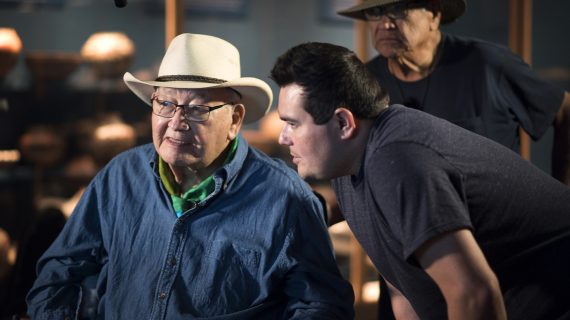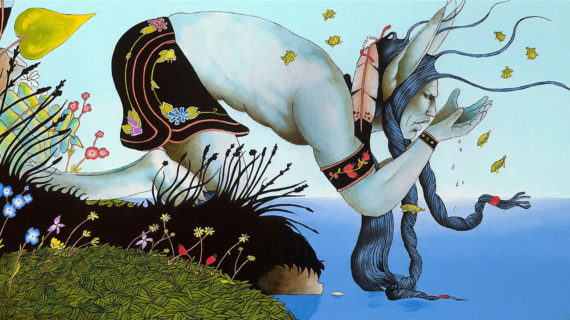– Welcome, everyone, to Wednesday Nite @ the Lab. I’m Tom Zinnen. I work at the University of Wisconsin-Madison Biotechnology Center. I also work for the Division of Extension Wisconsin 4-H. And on behalf of those folks and our other co-organizers, PBS Wisconsin, the Wisconsin Alumni Association, and the UW-Madison Science Alliance, thanks again for coming to Wednesday Nite @ the Lab. We do this every Wednesday night, 50 times a year. Tonight it’s my pleasure to introduce to you Lindsey Snyder. She’s a veterinary anesthesiologist here with the School of Veterinary Medicine. She was born and raised on the Kansas side of Kansas City, and then she went to Kansas State University for her undergraduate degree and stayed there to get her doctor in veterinary medicine. Then she went to Los Angeles for a year-long internship, and then went to Ohio State University to do her residency in veterinary anesthesia and analgesia. While she was at Ohio State, she also earned her master’s degree. Here at UW-Madison, she teaches, practices, and does research at the Department of Surgical Sciences in the School of Veterinary Medicine. Tonight, she’s gonna speak with us about acupuncture in animals. Would you please join me in welcoming Lindsey Snyder to Wednesday Nite @ the Lab?
– Thank you so much, Tom. I’m happy to be with you tonight to talk about acupuncture in animals. And I should first tell you how I came to study acupuncture and animals. And I am a veterinary anesthesiologist, and I did my residency at Ohio State University. And when I arrived, we also did master’s projects. So I got my master’s at the same time that I was doing my residency, and I showed up, and they had a project ready and waiting for me. And that project was looking at acupuncture, electroacupuncture, and a transcutaneous electrical current, which just means a current going across the brain, external to the skull, so this current going through the brain.
So looking at these three methods and looking at the requirements of inhalation anesthetics in dogs. So what we are looking at is would acupuncture, electroacupuncture, and this electrical current, would they decrease the gas anesthetic requirements of dogs? And this is kind of a universal method for determining if something causes analgesia in a patient. And I went into it thinking, “I don’t really wanna do this project because I don’t really believe in acupuncture.” And what I did was I proved that all three of these methods did, in fact, decrease the need of general anesthesia in dogs, but I also proved to myself that acupuncture does have significant effects in animals and humans. This paper based on my research was published in 2005, and at the time, it was one of the first papers that really had an objective method for evaluating acupuncture’s effects in an animal that had no placebo effect. And so it was sort of revolutionary at the time, and again, the academic community really liked it, and it made a believer of me, who went into it very much skeptical. So I’ve learned quite a bit about acupuncture throughout my time as being a veterinarian, not only through my master’s, but then I went on and got further training.
So what is acupuncture? Acupuncture itself is, by definition, it is the stimulating of specific anatomic points in the body to produce therapeutic or analgesic effects. So what does that mean? We can not only produce pain management so that analgesia, where we can decrease pain in a patient, but we can also get therapeutic effects like regulating how the GI system is working. So something like that. Traditionally speaking, when someone talks about acupuncture, they typically think of the traditional method of acupuncture, which is using fine gauge needles to puncture the skin in these specific anatomic points. Interestingly, we can use many different methods to actually produce these effects. So we can use heat, pressure, aqua, or a liquid of some sort, even electroacupuncture, using a low-level electrical current. So if we look at some of these, we can use heat. So if we start sort of clockwise in the top left corner, that’s actually using an herb called mugwort. Mugwort burns very, very hot. And so just even placing this herb over an acupoint can produce an effect in this acupuncture point, this specific anatomic point. We can also use pressure. So you can see someone is pushing on their hand in a very sort of traditional spot that a lot of people see when they have a headache, they’re pushing on their hand in this spot, and that’s using pressure to get an effect in this acupoint. What they’re doing here is actually stimulating a master point for the head and face.
You can see, as we move along clockwise, there’s actually a needle with liquid. And we can use liquid and inject that into an acupoint to get an effect. So we can use saline, we can use vitamin B12. We can even use the patient’s own blood, called hemopuncture. We can even use really small amounts of a drug and do what’s called pharmacopuncture and deliver very small amounts of a drug into an acupoint. In the bottom right corner, you can see that we’ve actually, in this, this was part of my study dogs, and we actually attach very small clips onto acupuncture needles, and we’re able to deliver a very low electrical current between two needles to develop or enhance the effect of the acupuncture alone. So this is just another method of stimulating those needles. You can see in the bottom middle picture, they’re using pressure with, those are actually motion sickness bands that are being used to put pressure and use acupressure on points that are really beneficial for decreasing nausea. And in the bottom right, you can see that they’ve actually used that same herb, mugwort, and actually put it in a cup attached to the acupuncture needle itself, and that warms the needle down into the acupoint. So that is going to intensify the effects of the acupuncture. I personally don’t use this method. As you can see in the picture, it is a burning substance, and if anyone’s ever been in a barn, there’s usually a lot of hay and a lot of straw, and it makes me a little bit nervous to do that. So each practitioner develops their methods for stimulating those acupuncture points.
So something that’s been interesting in more recent years, even more than, not even 20 years ago, you would not have found that places like Johns Hopkins were advertising acupuncture and its benefits on their websites. But now, not only the scientific community, but the medical community have really caught on to the beneficial aspects of acupuncture and what it can do. So you can see that Johns Hopkins is even touting acupuncture’s beneficial effects right on its website. Additionally, you can see that something like the NIH is advertising acupuncture’s beneficial effects as well. And the NIH recognizes that acupuncture is beneficial, and acupuncture in all of its variations, electroacupuncture, et cetera. It’s beneficial for things like dental pain after surgery, headaches, myofascial pain. So those are those real deep aches and pains of your connective tissue, and even things like asthma.
The NIH is promoting acupuncture for these various conditions within the body. In a traditional sense, acupuncture is based on patterns of energy flow throughout the body. And these were thought to be meridians in the body, and it’s disruptions of this energy flow throughout the body that was thought to be the basis of disease in the body. So disruptions in these patterns of flow were what caused ailments in the body. Acupuncture has been described in writing as early as 1,000 BC. So it has been in practice that we have a written history of for at least 3,000 years. That being said, there are artifacts that indicate that acupuncture has actually been practiced for thousands of years even before that. Very sharp bones that were sharpened to a point and even stones that were sharpened to a point have been found that were most likely used as acupressure modalities. So acupuncture or acupressure tools that go back to even 5,000 years ago. So why would someone recommend acupuncture or seek it out as a treatment for either themselves or their animal? Well, first and foremost, acupuncture has virtually no side effects.
So it really is something that we can go into with the hopes that it will help and realistically know that it will not harm one, either themselves or an animal. Like most things that we try to alleviate pain or have a therapeutic effect, it might not be universally effective. So when I get a headache, I take ibuprofen. Ibuprofen works for my headaches, whereas another individual, ibuprofen is not what works for their headaches. And in reality, something like Tylenol might be beneficial for them. Acupuncture is the same way. It might really work well with one person, but might not be the method of choice for another person. For some things, it might be the only thing that we need to use. And again, I’ll use the headache example. If I have a headache, ibuprofen is usually enough for my headache to go away. However, it might not be the only thing that works. So if I have a really excruciating headache, I might need ibuprofen and something else with it. And acupuncture is the same. When I talk to clients about their animal, I’m never looking at just acupuncture. I’m looking at everything that goes together for that patient. So both the Western approach and the traditional approach, and I use them as adjuncts for one another. When we use acupuncture needles or pressure or something, whatever method we choose, we are gonna be activating that acupuncture point.
So what are acupuncture points? Well, we know that they’re cutaneous areas with high concentrations of specialized nerve endings. There are specialized nerve endings that are responsible for picking up pain impulses, and those are both A delta and C fibers. And acupuncture points have really high concentrations of both A delta and C fibers compared to surrounding tissues. We also know that acupuncture points have a high concentration of mast cells. Now, mast cells release histamine, and so if I really get a point that’s really dead-on on that point, I might get a little reddend area, and that is a really, really small, localized release of histamine from that acupuncture point. There are also high concentrations of capillaries and venules, so it’s not entirely uncommon to have a little bit of blood when you take the needle out. We also know that acupuncture points are areas of decreased electrical resistance. So there’s actually increased electrical conduction within the acupoint itself. So I find this so fascinating because thousands of years ago, these points were discovered and now science has said, “Wait a minute, there is something to these points. They are anatomically different from surrounding tissue.” Things that we know about acupuncture is that acupuncture can decrease muscle spasms. So just by placing a needle within a spasming muscle or an area of muscle that has a tight knot, it can relax that muscle in and of itself just by placing a needle. So this picture that you’re looking at is actually, that’s actually me with straight hair for the day, but I am actually going and having what’s called trigger point therapy.
So other areas of medicine have caught on to this effect of decreasing muscle spasms. When I go in, I have someone who is in physical medicine and rehab, so a specialist, who takes a needle and actually pistons that needle within my muscle knots. And every time those muscles fire, it starts to relax those muscles. Physical therapists also do what’s called dry needling, and they will use acupuncture needles targeting the musculature. So they’re not actually targeting acupoints, so they can’t call it acupuncture, but they’re using acupuncture needles to decrease the muscle spasms. So this is starting to translate into other areas of medicine. We also know that acupuncture can induce the release of neurotransmitters. So neurotransmitters will be released, and that will affect how the body responds to pain. So we can release neurotransmitters and decrease the pain experience overall.
Some of the big ones that we would talk about would be endorphins and dynorphins. So that’s working on the body’s endogenous opioid system. And when we talk about that, one of the things that often is brought up is with endorphins, we talk about a runner’s high. So that release of endorphins causing a runner’s high. Well, I can get a runner’s high without having to run, which is a delightful way for me to get a runner’s high. All I have to do is place acupuncture needles and get that release of endogenous endorphins. I also know that acupuncture then can be reversed with the opioid antagonist naloxone. So something that we can use to get rid of opioids within the body, and we can reverse the effect of opioids in the cases of overdoses or something like that. That drug can actually be used to reverse the effects of acupuncture. So we can actually reverse acupuncture’s effects through pharmacology.
So to understand acupuncture and its mechanism of action, we really need to understand the pain pathway. So pain starts at the area of a noxious stimulus. So that’s just something that causes pain. That could be mechanical, chemical, thermal, placing your hand on a hot pot, or in our case, we’ll say that this dog has its foot stepped on. So we take that impulse, that mechanical impulse of having the dog’s foot stepped on, and it will be transduced into an electrical signal. It then will be transmitted through transmission to the level of the dorsal horn of the spinal cord. That transmission will occur by those two specialized nociceptive fibers. So those two nerve fibers that are responsible for delivering pain. The first are the A delta. Those are large, myelinated fibers that are responsible for fast, pinprick pain. And the second are C fibers. Those are small, unmyelinated fibers that are responsible for slow, burning pain. So again, we have our impulse, it gets transduced into an electrical stimulus that then is transmitted to the level of the dorsal horn of the spinal cord. At that point, we can modulate the pain impulse. So we can have excitatory neurotransmitters that will intensify the pain experience, or we can have the release of inhibitory neurotransmitters like the endorphins that will decrease the pain experience. Then that impulse is projected to higher levels of conscious perception.
So with that in mind, we can look at one of the theories for how acupuncture creates its analgesic effects, and that is called the gate control theory. The gate control theory states that when we place these needles into the skin, we stimulate those large, myelinated fibers responsible for fast, pinprick pain. That gets carried to the level of the spinal cord, and the release of inhibitory neurotransmitters occurs, so we release things like endorphins, which will close the gate and decrease the pain experience from those slow, burning, more pathologic pain nociceptors, the C fibers. The small, unmyelinated fibers responsible for slow, burning pain. The points themselves are based on the meridian system of human acupuncture.
So it’s the same names and the same codes that we use in human acupuncture, and everything has a very specific anatomic location associated with it. For example, if I were to read spleen 6 is three cun directly above the tip of the medial malleolus on the posterior border of the tibia. Now, when I look at these different anatomic locations, I can look and say that the interior of the tibia is 13 cun, whereas the external portion of the tibia is 16 cun. But keeping that in mind that it’s 13 cun, then I know that this point, spleen 6, is approximately 25% more proximal up the level of the tibia. So working our way up the tibia, it’s gonna be approximately 25% up the level of the tibia. And so we find most of our points based on these anatomic descriptions. You can also use something like a point finder. A point finder is, it’s a small machine that actually looks for electrical resistance within the skin. This is beneficial in people. It’s not as beneficial in our veterinary patients that are covered with hair or fur.
When looking at something like chronic pain, we look at it like we would any other method of analgesia, in that I don’t look at an animal that has been suffering pain for weeks or months and expect that one pill of a pain medication is going to treat all of its pain. I know that I’m going to have to give continued treatment to see improvement, and that’s the same with acupuncture. So we really need to approach chronic pain with several treatments and know that these treatments will build upon each other and the effect will be additive, and that we should give it a number of treatments before we really assess whether the acupuncture is working or not for that particular patient. Electroacupuncture is simply, I pointed out earlier, is simply adding small clips to the needles themselves and adding a very low electrical current between those needles. The stimulation of needles creates a more profound analgesic effect. So I say that electroacupuncture is simply taking a highlighter to that effect, and we’re just highlighting that effect.
Now, we can stimulate the needles a couple of different ways. So you can rotate needles. They used to have women that would sit in a room, and they’d actually spin the needles up to 200 times a minute. I jokingly say that their carpal tunnel then kicked in and they could no longer spin the needles for them and needed acupuncture themselves. Other methods, if anybody has ever had acupuncture, sometimes, practitioners will come in and spin the needles periodically, or they’re actually, some individuals will come in and actually flick needles. But the most consistent method for stimulating a needle is adding that electrical stimulation. It is very repeatable in every patient. And that electrical stimulation is more intense than any of the manual manipulation could be. I point out this study, and you can see just as a fun aside, this is actually doing electroacupuncture on a giraffe that was anesthetized. They tend to have muscle contraction while they’re anesthetized. And so we were using electroacupuncture to keep the muscles soft and supple so that the giraffe could stand up without any complications there. And I point out this study because it’s really looking at the neurotransmitters that are released in the presence of electroacupuncture and acupuncture. And the point is not to read off all of these neurotransmitters, but you can see that there are different types of pain that was looked at, and looking at the periphery versus the spinal versus the central nervous system, and looking at all the different neurotransmitters that can be affected by using acupuncture and electroacupuncture, and how all of these neurotransmitters can affect the pain impulse and decrease the pain experience for both humans and animals.
So science has a lot to say about acupuncture. We know that neurotransmitters are heavily involved in the pain reduction that acupuncture can produce. We know that it decreases muscle spasms and improves comfort in patients. I’ve not really even discussed the therapeutic benefits, but the science community is aware that all of these things are happening. What I think is really fun then is to pay homage to the history of acupuncture and to really talk about some of the traditional Chinese medicine as well. This is often, when we talk about acupuncture, this is where we start to lose people a little bit is when we start to talk about traditional Chinese medicine and the aspects of traditional Chinese medicine. People tend to go towards the science side and the traditional Chinese medicine loses them a little bit, which is one of the reasons that I love talking about it with all of the clients while I’m treating their patients and to really incorporate the history with the science. So traditional Chinese medicine has five components, with acupuncture just being one component. So you can see that, obviously, acupuncture is one of the components of traditional Chinese medicine. But the other components include herbal medicine. And herbal medicine, again, this is something where some people sort of glaze over and they don’t quite, you know, treating things with herbs seems very difficult for certain individuals to wrap their head around.
But really, I could go back and say that morphine is actually a derivative of the poppy plant. And so morphine in and of itself is a type of herbal remedy. So we can develop synthetic opioids following that, but really, the gold standard opioid morphine is an herbal remedy. And so herbal medicine really targets what’s happening within the body, and individuals would describe it as daily acupuncture, very specific daily acupuncture. So really getting targeted therapy to what is happening within the body. Another component of traditional Chinese medicine is massage, and this is called tui na. And tui na is not a lovely, relaxing massage. It is actually a very intense massage, where most people will describe it as the end justifies the means. It can be quite uncomfortable during the process, but produces very beneficial effects in targeting meridians and targeting pressure points within the body.
Another component is exercise, which is qigong, which is an exercise that is very similar to Tai chi and really incorporates the mind-body connection. So it is slow movements that promote health in the joints, as well as having that mind-body connection. I jokingly say that I have yet to get my dog to do Tai chi with me in the morning, but what I can do is have a relaxing walk with my dog to incorporate that exercise. So it’s not about running and getting his heart rate up and moving as quickly as possible, but it is about more relaxation and movement of the body.
And then the last component is food therapy. Food therapy is a really interesting topic. It is much more than just eat the right thing and you’ll feel better. Food therapy really targets cooling food and warming food, and looking at individuals. It’s using food as medicine. And when I talk to people about this, I usually have, if I’m in a group, I’ll have people raise their hand if they’re always cold. And inevitably, there will be people in the group that raise their hand, and I can say, “One of the things you can try is to incorporate cinnamon into your diet.” Cinnamon is a warming herb, and it can actually warm the body from the inside. Then you can ask the same question in opposite and say, “How many people are hot all the time?” And inevitably, there are people that raise their hand. Try incorporating mint into your diet. Mint is a cooling herb. Well, beyond herbs, there are proteins that are cooling and warming, and spice and spice level plays a component in this. And so it’s really looking at food as medicine to treat what is ailing someone in the body.
On a traditional basis, as I mentioned, acupuncture has been utilized in writing, at least, for 3,000 years, and realistically, it’s probably been practiced for longer than that. It’s thought that traditionally speaking, a decrease or increase in energy flow or qi along hypothesized lines or channels within the body are the basis for disease within the body. And these hypothesized channels are called meridians. In reality, the meridians have never been demonstrated to exist. That being said, there are studies out there that say that there’s something to them. So we have found, scientifically, we’ve found that the meridian systems themselves, there are multiple meridians in the body, but those meridians follow nerve pathways or they follow connective tissue in the body. So they’re actually following anatomic structures within the body. And they actually have found that some of the points themselves are right over major connections of connective tissue within the body, and even over areas where there is connective tissue that dives deep in between musculature and incorporates a lot of the nerve fibers. So these points follow these fascial planes in the body. These meridians follow them. We also have found that the meridians tend to be right over big neuronal bundles within the body. So these two studies are looking at those and saying that there’s actually something to these meridians. Although we can’t prove that they anatomically really exist, we know that they follow structures that exist. On a traditional basis, pain is a result of excess conditions leading to obstruction of circulation within that meridian.
So we can have exterior pathogenic factors. Scientifically speaking, we could say that that’s a heavy flu season or a high level of ragweed in the air. Those would be those exterior factors. It could be interior cold or heat, stagnation of qi or blood. And all of this is a little hard to understand at first, of course, because it’s really just learning a new language associated with acupuncture, and it’s this language of internal medicine before there was internal medicine. So although it sounds, talking about something like qi might be a little bit hard to wrap your head around, it’s really describing things before Western medicine described it in a different way. It’s really just using a different language to describe very similar things. And so again, I think it’s important that we learn some of this language so we can translate between the two. On a traditional basis, pain can also be a result of deficiency conditions. So deficiency of qi, blood, consumption of bodily fluids.
You can also have a situation where you just have stagnation of qi, which causes a distending pain with no real pinpoint location to that pain. And the best description I could give of that is depression. People with depression often describe pain without a real fixed location for where that pain is occurring. So the idea is that we wanna restore balance within the body. We wanna take the body to homeostasis. And what is homeostasis? I got into this discussion not long ago with an individual. What is homeostasis? Homeostasis is not a universal term for every individual, but it’s for that specific individual. So we wanna take that individual, that individual animal, that individual person, we wanna take them back to their baseline at which their body performs in the best way possible. So we are trying to take it to their baseline that allows them to have optimum health. So needles placed in appropriate locations will help to alleviate any of these underlying causes of pain, or obstruction, or decreased circulation within the meridians. And, therefore, we can alleviate pain, and we can create therapeutic effects.
So how do we get there? How do we know where to place our needles? Well, we do that by developing what’s called a pattern diagnosis. A pattern diagnosis is simply a traditional Chinese medicine diagnosis. We do that using some terminology that’s a little bit different. The first is yin and yang. Yin and yang are in opposition of one another. And I think of yin as cool and dark. So it is nighttime, it is the moon, associated with nighttime. It is cold, and so it is winter as far as a season. Things slow down in the winter. As compared to yang, which is bright, and sunny, and warm, and things are moving fast, and it’s summer. And so we look at these different things. And how does this come into play? Well, I might. . . Well, I can use the example, I should say, of something that creates yang excess. So an animal that is hot, that can be yang excess, meaning a fever, or we can have an individual that is hot because of yin deficiency. So a woman going through menopause, she does not actually have a fever, she is not excess yang. Instead, her cooling system is broken, causing her to be warm from time to time. So she has yin deficiency.
So it’s just looking at it in two different ways. So we can apply yin and yang when looking at a patient. We can apply it to the body. So parts that see the sun on one of our patients, a veterinary patient, that’s gonna be the back, that’s gonna be the outside of the limbs. Those are yang meridians that pass through those areas. We also have yin meridians. The yin meridians are gonna be on the abdomen, they’re gonna be on the inside of the legs, the areas that are dark; they don’t see the sun. And if I’m looking at a situation where a patient has a yin deficiency, I’m probably gonna wanna stimulate yin points to build up the yin system. And it’s gonna help us in determining our pattern diagnosis or our diagnosis.
We can also use the five element theory. And the five element theory is really fun to talk about because I’ll discuss the five elements, and then sort of get to some of the fun parts as well. But the five elements go in this order. Wood, fire, earth, metal, and water. And each of those elements has a color associated with it, it has a taste associated with it, and it has organs. So the zang-fu organs associated with each. Each of those has a yin and a yang organ. So I can choose the organ system that would be yin or yang for that particular animal. There are also sense organs and body parts, and we can go through all of these, and you can see that there are, as I said, specific organs associated with the different elements. But that doesn’t mean much yet. But we can actually apply these to conditions within the body and personality, and that’s where it gets fun. When I teach this in the vet school, I actually add links to quizzes that you can take online that tell you which element you are, your personality.
So I’ll go through. The wood personality is a very take-charge personality. They are the cruise director. They’re gonna tell everyone where we’re going, and what we’re doing, and this is when we’re gonna go, and please be on time. For animals, I think of a police horse needing to be a wood. They need to be take-charge and they need to not back down when people are coming at them. So that’s kind of your wood personality in a nutshell. When they are out of balance, when woods are out of balance, they’re prone to tendon and ligament issues. The fires, those are the social butterflies. And they are the poodle that comes up and greets everyone at the dog park. Dog park, every dog at the dog park, every person at the dog park, and they’re friends with everyone. They wanna come up and lick your face. That’s your fire. We all know social butterflies as well, and oftentimes, they are prone to having arrhythmias. They also can be prone to anxiety. The earths, they’re the laid-back individuals. So the earths are the very mellow Lab who is extremely friendly but doesn’t feel the need to be in your face. They’re going to greet you eventually when you come to the door, but again, they’re not gonna charge you down and try and lick your face. So very mellow. Older Lab is a classic example. And they are prone to worry, and they’re prone to overeating. So they’re actually prone to weight gain when they are out of balance. I myself am mostly an earth, and do consider myself to be pretty laid-back. And sure, I like to eat as well. The metals are best described in animals as aloof. In humans, we would describe them as individuals that are a little antisocial or introverted, individuals that like to be by themselves, and they are extremely meticulous. So individuals that will unpack the dishwasher to put it in the right way. Those are your metals. In animals, how that manifests is that they’re the animals that wake up at the same time every day, they eat from the same food bowl every day. If you incorporate a new food bowl, they won’t eat. And so they’re very routined animals. When they are out of balance, they’re prone to skin issues and allergies and asthma. And then the last are the waters. They’re extremely loyal to a small group of people. So they’re very loyal family animals, but not the most social. They are extremely loyal in people to a small group of friends and don’t feel the need to be friends with everyone, but profoundly loyal to their group. In animals, we describe them a little bit as fear biters. And then when they are out of balance, they are prone to osteoarthritis, and they can be prone to some kidney concerns. So there are personalities associated with all of these.
Additionally, they are phases of life. So wood being the first phase of life, going through the phases of life, lastly, the water phase of life. So if you look at water as the last phase of an individual’s life, a geriatric animal, or a geriatric individual, a geriatric human, you’ll see osteoarthritis is there ’cause bones are the body part. The sense organ is the ears. It’s very common for individuals to lose their hearing. Kidney and bladder; we see urinary incontinence occur much more in our older populations. So we use these to help us develop that pattern diagnosis. So I ask a lot of questions about an animal’s personality. So to see what they’re predisposed to. It also helps in determining how we can balance that individual. Because the ideal situation is that someone is such a perfect combination of all five of these personalities that nobody can tell what they are because they are so well-balanced between all of the elements. Oftentimes when people take the quiz, they’ll find that is not the case.
So we also talk about qi, and qi is one of those things, as I said, that gets really hard for people to wrap their head around. Well, qi is best if we really just break it down into the words like energy or health. I’d really like to use the word health in place of qi. So when I talk about improving qi in a limb, what I might really be saying is I want to improve the health of that limb because in reality, qi is an overarching, all-encompassing term for many smaller components of qi. For example, there’s something called gu qi. And on my diagram, you can see it’s sort of in the top left. Gu qi, and that is food qi. That is the energy or the health that you get from food. So we all know that if you eat healthy food, you will be in better health than if you eat food that is not as healthy for you. That is something that’s been proven time and time again, and we know it from elementary school on. There’s also qi associated with environmental factors. So when the pollen is really high, I am not gonna be in as good of health because I have seasonal allergies. There’s also the immune system qi. So all of these different components that make up qi. So when I am saying qi, I’m actually describing something that has multiple smaller components to it. And when we start to break that down and really look at it, we can understand how qi can be the, it’s all-encompassing word, and it makes it a little bit more digestible for people that have a hard time talking about qi or energy within a body. So we use things like yin and yang, and our organ systems, and our five element, and we make a pattern diagnosis. And when we do that, we might also incorporate a few other things in addition to their personality and things like that.
We can include pulses. So practitioners that are really adept at traditional Chinese medicine can actually feel pulses differently in three locations. Along the wrist and the wrist here. In animals, we might use their femoral pulses, so just on the inside of the back legs. But you can actually feel the pulse differently in each location, and you can actually start to interpret what is happening within the body based on the strength of the pulses in these different locations. I’ve been doing acupuncture for many, many years, 15 years-ish, and I am not adept at doing this. There are practitioners that will feel pulses for 10 to 15 minutes, and they’ll be able to list off all the things that are wrong with you with a high degree of accuracy. So there are people that are extremely skilled at feeling pulses. I do look at tongue. So we don’t think of the tongue as having changes in color necessarily, but there are actually locations of the tongue that are associated with different elements, or we can say the organs that are associated with those elements.
So you can see spleen and stomach in the center. And so we can look at that, and we can look at the color changes of the tongue in these different locations to see what is happening within the body. So a really good example is a pale tongue being qi deficient. So when I look at the color of the tongue, when veterinary students are going through finals, they almost all have qi stagnation, which is the lower left corner. That is a pale tongue in the middle, so that’s that qi deficiency in the middle, but where the heart is, and I said anxiety is associated with heart, with that fire element, they get a bright red tongue. And so during finals time, almost all the students have a pale tongue with a bright red tip. And so we see these changes, and it can help us determine what is happening within the body. And you say, “Well, how can the tongue actually look that different?” Well, it can look quite different. So you can see our friend in the top left corner has a little bit more of a pale center with a brighter red tip. The ideal color is called peach petal. And the dog on the bottom has that color more around the edge of the tongue, with it being a little bit more pale in the spleen center. The dog in the top right has more of that red, dark red color, which if it starts going a little bit towards a purple is an indication of stagnation, which is usually stress or pain in the body. So I’m definitely gonna be looking for pain within that patient.
So I take all of these factors into account when I am looking at a particular patient, and I develop a pattern diagnoses or a diagnosis, so that I can treat the patient as an individual. So if I’m looking at acupuncture for something like osteoarthritis, I’m gonna look at each case individually. Western medicine might treat patients very similarly, whereas the acupuncture in the traditional Chinese medicine is gonna parse it out a little bit more. So I might look at two patients that actually are very similar in their presentation. So they both have a history of osteoarthritis. NSAID’s help, but lately, it hasn’t been helping. I then gather more information about each of these patients. I ask questions about their personality. So it looks like Max is pretty mellow and easygoing, more likely an earth, whereas Hank is that fear biter; he’s a water. And I start to see that Max is seeking out warm locations. So he’s cold a lot, whereas Hank is the opposite. And I look at their tongue and I make a pattern diagnosis. And these two cases that come in looking very similar actually have two different pattern diagnoses. Max has kidney yang deficiency, whereas Hank has kidney yin deficiency. So they sound very similar, but they can be treated individually. So I can pick points that are very similar for both of them that are just going to be points that are gonna work on the areas of the body that hurt, but I also can work on points that treat that underlying pattern diagnosis. So, for one, increasing the yin within the body. The other is really toning down the yang within the body. And so we start to balance it that way, and we treat them as individuals with the points that we choose. And there are nice flow charts that help us with this in the beginning because it is a lot to learn, and a lot to understand, and a whole different language, as I said, from the Western medicine perspective, and the Western medicine approach, and the traditional Chinese medicine approach.
So I wanted to share this with you because I’m passionate about acupuncture, and I want people to understand that we can talk about the history and we can talk about these things like yin and yang without alienating the Western medicine and the science that comes and goes hand in hand with acupuncture. So it’s really marrying the traditional Chinese medicine approach and the scientific approach, and using them both in combination to do what is best for the patient. So I thank you for sticking with me throughout this talk. And I hope that you learned something and are open to talking about acupuncture in the future. Thank you so much.
Search University Place Episodes
Related Stories from PBS Wisconsin's Blog

Donate to sign up. Activate and sign in to Passport. It's that easy to help PBS Wisconsin serve your community through media that educates, inspires, and entertains.
Make your membership gift today
Only for new users: Activate Passport using your code or email address
Already a member?
Look up my account
Need some help? Go to FAQ or visit PBS Passport Help
Need help accessing PBS Wisconsin anywhere?

Online Access | Platform & Device Access | Cable or Satellite Access | Over-The-Air Access
Visit Access Guide
Need help accessing PBS Wisconsin anywhere?

Visit Our
Live TV Access Guide
Online AccessPlatform & Device Access
Cable or Satellite Access
Over-The-Air Access
Visit Access Guide
 Passport
Passport


















Follow Us